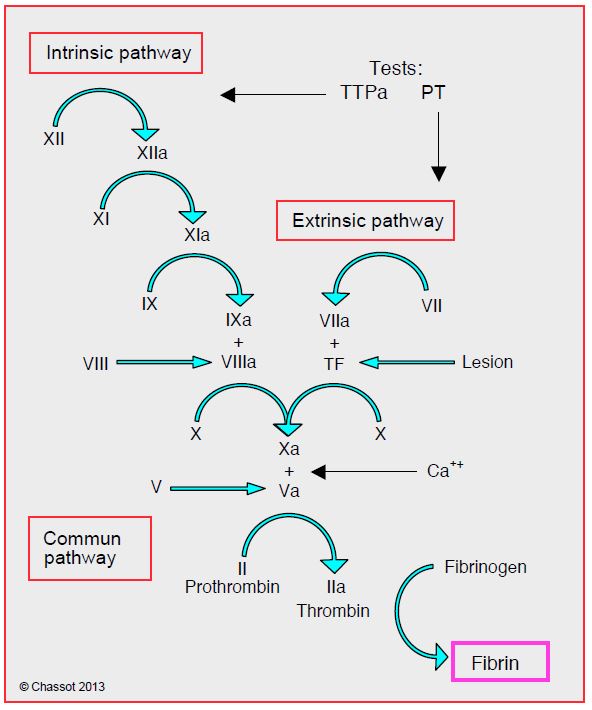The cascade concept of successive reactions in which each element becomes the enzyme or cofactor required for the next reaction dates back to 1964 [1]. It helped clarify the sequence of steps taking place in an in vitro tube. It is based on the existence of an intrinsic, purely serum pathway and an extrinsic pathway initiated by endothelial injury. These two pathways merge into a common pathway leading to the formation of fibrin. In simplified terms, the reactions are as follows (Figure 8.1).
Figure 8.1: The classic coagulation cascade. It only takes into account serum factors as they can be tested in vitro, but is very useful for understanding the different coagulation tests. It is divided into an intrinsic pathway, purely serum based, and an extrinsic pathway, initiated by endothelial injury. These two pathways merge into a common pathway at the level of factor Xa (FXa). Most factors form an enzymatic cascade, while factors V and VIII are cofactors for factors X and IX respectively. aPTTt: activated partial thromboplastin time (aPTTt); assesses the intrinsic and common pathways. PT: prothrombin time; assesses the extrinsic and common pathways. TF: tissue factor [2,3].
- Intrinsic pathway: the activation of factor XII (Hageman factor) to F XIIa leads to the activation of factor XI and then factor IX; combined with factor VIIIa, the latter activates factor X. This factor Xa is at the centre of the cascade, at the junction of the three pathways.
- Extrinsic pathway: Tissue factor (TF) is a trigger that is found in tissues (fibrocytes, collagen) normally outside the vascular endothelium and protected so from blood ; it activates factor VIIa and functions as its receptor.
- Common pathway: Factor Va is the cofactor of factor Xa; together they form the prothrombinase complex which converts prothrombin (factor II) into thrombin (factor IIa). Thrombin is the final element that transforms soluble fibrinogen into a fibrin gel.
The activated partial thromboplastin time (aPTT) reflects the function of the intrinsic and common pathway components, while the prothrombin time (PT) reflects that of the extrinsic and common pathways. The intrinsic and extrinsic pathways are not independent of each other and cannot replace each other when one factor is deficient, such as in factor IX (intrinsic pathway) or factor VII (extrinsic pathway) deficiency. The TF-FVIIa complex can activate both factor X and factor IX, but it cannot compensate for a lack of IXa/VIIIa complex [181]. Although this cascade correctly explains coagulation in vitro, it is not appropriate for the in vivo situation, in which thrombocytes and the endothelium play a crucial role.
| Coagulation cascade |
| The coagulation cascade illustrates a sequence of serum based factors that activate each other in vitro. It includes an intrinsic, purely serum based pathway and an extrinsic pathway, which originates from tissue injury. These two pathways converge into a common pathway leading to the formation of thrombin and the conversion of fibrinogen to fibrin. The PTT reflects the functioning of both elements the intrinsic and common pathways, whereas the PT reflects that of the extrinsic and common pathways. This cascade explains well the events that take place in blood isolated inside a tube, but it does not explain well what happens inside a vessel. |
© CHASSOT PG, MARCUCCI Carlo, last update November 2019.
References
- DAVIE EW, RATNOFF OD. Waterfall sequence for intrinsic blood clotting. Science 1964; 164:1310-2
- HOFFMAN M, MONROE DM. A cell-based model of hemostasis. Thromb Haemost 2001; 85:958-65
- ROBERTS HR, MONROE DM, ESCOBAR MA. Current concepts of hemostasis. Anesthesiology 2004: 100:722-30

